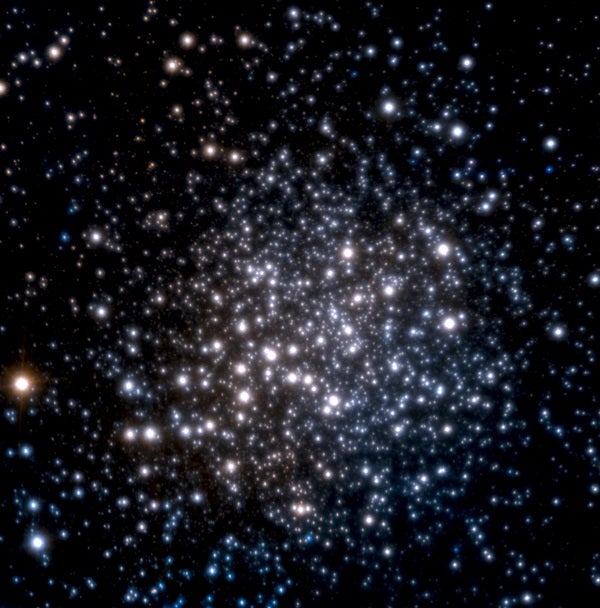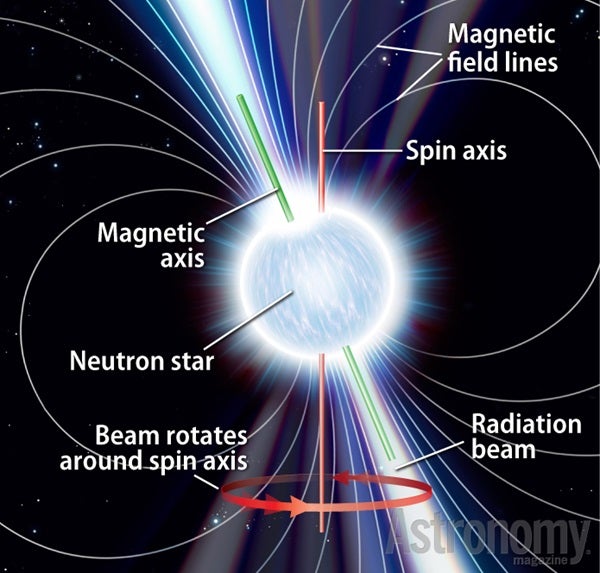Key Takeaways:
- PSR J1748-2446 is the fastest spinning object in the universe, rotating 716 times per second.
- It is a neutron star, the densest object known to exist, with a surface harder than diamond and a magnetic field a trillion times stronger than the Sun’s.
- PSR J1748-2446 is part of a binary star system, with its companion star blocking 40% of its light every 26 hours.
- The star is located in the globular cluster Terzan 5, which is 18,000 light-years away and difficult to see due to dust.
- PSR J1748-2446 emits a continuous stream of radio waves, which is how it was discovered in 2004.
What makes PSR J1748–2446 famous for its weirdness? Easy. It is the celestial object that spins the fastest in the universe. It’s also a star whose surface is not just solid, but harder than a diamond. Compared to lead, its density is 50 trillion times higher. Compared to our Sun, its magnetic field sizzles a trillion times more intensely. It is, in essence, the most extreme form of neutron star.
When a heavy sun explodes in a supernova, the core of the sun, which has the mass of several million Earths, collapses into a tiny sphere and the rest of the sun shoots outward. This is how neutron stars are created. When this occurs, the inverse-square law of gravity goes into its demo-mode with a vengeance.
Gravity has free reign because this star lacks a fusion generator, which means there is no pressure generated outward to prevent it from collapsing. When the collapsing star gets five times smaller, its inward-pulling surface gravity becomes 25 times fiercer. When the star shrinks to 100 times smaller than it was before, its surface gravity now sucks inward with 100 x 100 (i.e., 10,000) times more force — and it keeps going. The star’s collapse becomes more violent as it gets smaller.
Normal 1-solar-mass stars stop collapsing when they’re the size of Earth. Then, because each electron requires some breathing room, electron degeneracy pressure puts an end to the performance. However, if a star’s mass exceeds the well-known Chandrasekhar limit, which PSR J1748–2446 initially possessed, then electrons are forced into the protons and the collapse continues. At this point, the previously separate atomic particles lose their identities. Everything becomes a neutral ocean of ultra-dense goo, and a few million Earths now pack into a ball less than 20 miles (30 kilometers) wide — a star that could barely cover Los Angeles.
Its spin ratchets up, too, like an over-caffeinated ballerina. Frequently, these collapsed stars spin 20, 30, or even 100 times per second. However, if a neutron sun has a companion star, as this one does, it can accelerate even more with newly captured material. 716 spins of PSR J1748–2446 spins every second!

It’s hard to visualize. The fastest-spinning object we may observe in daily life is the blade on a circular saw or kitchen blender. But those never rotate more than a few hundred times a second. The equator of this star rotates at a quarter of the speed of light. This 43,000-mile (70,000-kilometer) per second rotation would be equivalent to the equator of Earth doing nearly two spins per second rather than one per day.
Imagine living there. Taxes would be very low, but there’d also be several significant drawbacks. The gravity would crush you down so that your protoplasm would spread itself evenly around the surface like a film of oil. It was impossible to stand higher than one atom. But if you could still somehow remain conscious, you’d see every star in the sky cross the heavens from horizon to horizon in less than a thousandth of a second, each appearing as a solid line. Studying the universe could be difficult.
PSR J1748–2446 does, in fact, rotate as quickly as it can. It would launch its material into space like whipped cream thrown into a fan if it traveled any faster.
Neutron stars emit rapid bursts of energy every time they rotate, much like a lighthouse. PSR J1748–2446 emits a continuous, incredibly fast series of flashes in an extensive range of wavelengths. In fact, this object was originally discovered in 2004 at radio frequencies by Jason Hessels of McGill University in Montreal, Canada. Visually, its light looks steady because nobody can differentiate so many flashes per second, which is 30 times faster than those from a movie projector.

A “quark star” is the only object that is currently visible that has the potential to be denser than this crushed “superball.” When scientists said in 2002 that they had discovered precisely such an object, the evidence was criticized by almost the whole astrophysical community, leading to the object’s rejection. Thus, as of right now, the record is in place.
Situated in a globular cluster of stars in Sagittarius the Archer, 18,000 light-years away and pointed towards the center of our galaxy, lies the fastest-ever pulsar. Called Terzan 5, the cluster is hard to see because foreground dusty gas heavily obscures it. Being the only cluster with a higher star concentration than any other and containing stars from various eras, Terzan 5 is actually highly unique in and of itself. Some think this cluster is actually the remnant of a dwarf galaxy cannibalized by our Milky Way.
PSR J1748–2446 is also weird because it is part of a binary star system. Its companion is a swollen giant that nonetheless contains just one-seventh our Sun’s mass; this pair whirls around each other in a perfectly circular orbit every 26 hours. Doing so, the companion passes in front of the pulsar daily, blocking 40 percent of its light. This gives its ultra-fast flashes an accurate clockwork dimming, allowing it to be simultaneously variable in two ways.
The whole thing just gets curioser and curioser.


